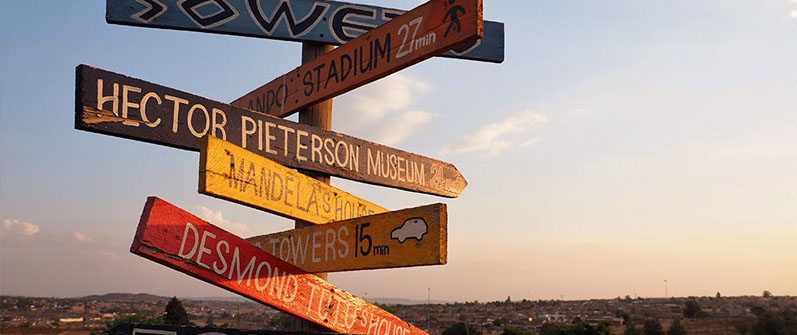Soweto tour: Tailored for you.
This soweto tour lets you explore this vibrant historic township from the contrasting lifestyles with mansions to overcrowded informal settlements, to grand street markets.
George Harrison and George Walker are today credited as the men who discovered an outcrop of the Main Reef of gold on the farm Langlaagte in February 1886. The fledgling town of Johannesburg was laid out on a triangular wedge of “uitvalgrond” (area excluded when the farms were surveyed) named Randjeslaagte, situated between the farms Doornfontein to the east, Braamfontein to the west and Turffontein to the south.
Within a decade of the discovery of gold in Johannesburg, 100,000 people flocked to this part of the Zuid-Afrikaansche Republiek in search of riches. They were of many races and nationalities. In October 1887, the government of the South African Republic (ZAR) bought the south-eastern portion of the farm Braamfontein. There were large quantities of clay, suitable for brickmaking, along the stream. The government decided that more money was to be made from issuing brick maker’s licences at five shillings per month.[9] The result was that many landless Dutch-speaking burghers (citizens) of the ZAR settled on the property and started making bricks. They also erected their shacks there. Soon, the area was known either Brickfields or Veldschoendorp. Soon other working poor, Coloureds, Indians and Africans also settled there. The government, who sought to differentiate the white working class from the black, laid out new suburbs for the Burghers (Whites), Coolies (Indians), Malays (Coloureds) and Black Africans (Africans), but the whole area simply stayed multiracial.
Soweto was created in the 1930s when the White government started separating Blacks from Whites, creating black “townships”. Blacks were moved away from Johannesburg, to an area separated from White suburbs by a so-called cordon sanitaire (or sanitary corridor) which was usually a river, railway track, industrial area or highway. This was carried out using the infamous Urban Areas Act of 1923.
William Carr, chair of non-European affairs, initiated the naming of Soweto in 1959. He called for a competition to give a collective name to townships dotted around the South-west of Johannesburg. People responded to this competition with great enthusiasm. Among the names suggested to the City Council was KwaMpanza, meaning Mpanza’s place, invoking the name of Mpanza and his role in bringing the plight of Orlando sub tenants to the attention of the City Council. The City Council settled for the acronym SOWETO (South West Townships). The name Soweto was first used in 1963 and within a short period of time, following the 1976 uprising of students in the township, the name became internationally known.
Soweto became the largest Black city in South Africa, but until 1976, its population could have status only as temporary residents, serving as a workforce for Johannesburg. It experienced civil unrest during the Apartheid regime. There were serious riots in 1976, sparked by a ruling that Afrikaans be used in African schools there; the riots were violently suppressed, with 176 striking students killed and more than 1,000 injured. Reforms followed, but riots flared up again in 1985 and continued until the first non-racial elections were held in April 1994. In 2010, South Africa’s oldest township hosted the FIFA World Cup Final and the attention of more than a billion soccer spectators from all over the world was focused on Soweto. Enjoy our soweto tour.

Tour highlights
- Nelson Mandela’s House
- Hector Pietersen Memorial
- Soweto Towers
- Vilakazi Street

